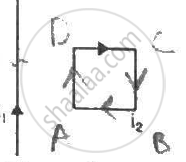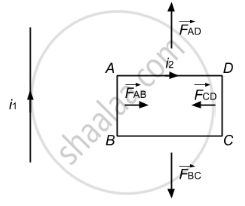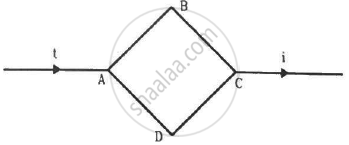Advertisements
Advertisements
प्रश्न
Consider the situation shown in figure. The straight wire is fixed but the loop can move under magnetic force. The loop will

विकल्प
remain stationary
move towards the wire
move away from the wire
rotate about the wire.
उत्तर
move towards the wire

`vec (F}_(AD) + vec(F}_(BC)= 0`
`vec(F)_(AB) > vec(F)_(CD)`
Force acting on the wire per unit length carrying current i2 due to the wire carrying current i1 placed at a distance d is given by
\[F_{AB} = \frac{\mu_o i_1 i_2}{2\pi d} (\text{ Towards the wire })\]
\[ F_{CD} = \frac{\mu_o i_1 i_2}{2\pi(d + a)} (\text{ Away from the wire })\]
Here, FAB > FCD because force is inversly proportional to the distance from the wire and wire AB is closer to the wire carrying current i1.
The forces per unit length acting on sides BC and DA will be equal and opposite, as they are equally away from the wire carrying current i1, with current i2 flowing in the opposite direction.
∴ FBC = - FDA
Now,
Net force :
\[F = F_{AB} + F_{BC} + F_{CD} + F_{DA} \]
\[ \Rightarrow F = \frac{\mu_o i_1 i_2}{2\pi d} + F_{BC} - \frac{\mu_o i_1 i_2}{2\pi(d + a)} - F_{BC} \]
\[ \Rightarrow F = \frac{\mu_o i_1 i_2}{2\pi}\left( \frac{1}{d} - \frac{1}{d + a} \right)\]
\[ \Rightarrow F = \frac{\mu_o i_1 i_2 a}{2\pi d(d + a)}\]
(Towards the wire)
Therefore, the loop will move towards the wire.
APPEARS IN
संबंधित प्रश्न
Use Biot-Savart's law to find the expression for the magnetic field due to a circular loop of radius 'r' carrying current 'I', at its centre ?
A current-carrying, straight wire is kept along the axis of a circular loop carrying a current. This straight wire
A steady electric current is flowing through a cylindrical conductor.
(a) The electric field at the axis of the conductor is zero.
(b) The magnetic field at the axis of the conductor is zero.
(c) The electric field in the vicinity of the conductor is zero.
(d) The magnetic field in the vicinity of the conductor is zero.
Figure shows a square loop ABCD with edge-length a. The resistance of the wire ABC is r and that of ADC is 2r. Find the magnetic field B at the centre of the loop assuming uniform wires.

Two circular coils of radii 5.0 cm and 10 cm carry equal currents of 2.0 A. The coils have 50 and 100 turns respectively and are placed in such a way that their planes as well as the centres coincide. Find the magnitude of the magnetic field B at the common centre of the coils if the currents in the coils are (a) in the same sense (b) in the opposite sense.
Two circular coils of radii 5.0 cm and 10 cm carry equal currents of 2.0 A. The coils have 50 and 100 turns respectively and are placed in such a way that their planes as well as the centres coincide. If the outer coil is rotated through 90° about a diameter, Find the magnitude of the magnetic field B at the common centre of the coils if the currents in the coils are (a) in the same sense (b) in the opposite sense.
Find the magnetic field B due to a semicircular wire of radius 10.0 cm carrying a current of 5.0 A at its centre of curvature.
A circular coil of 200 turns has a radius of 10 cm and carries a current of 2.0 A. (a) Find the magnitude of the magnetic field \[\vec{B}\] at the centre of the coil. (b) At what distance from the centre along the axis of the coil will the field B drop to half its value at the centre?
Which of these equations is the correct expression for force on a charge in magnetic field?
If we double the radius of a coil keeping the current through it unchanged, then the magnetic field at any point at a large distance from the centre becomes approximately.
A charged particle moving in a uniform magnetic field and losses 4% of its kinetic energy. The radius of curvature of its path changes by ______.
A short bar magnet has a magnetic moment of 0. 65 J T-1, then the magnitude and direction of the magnetic field produced by the magnet at a distance 8 cm from the centre of magnet on the axis is ______.
A small square loop of wire of side l is placed inside a large square loop of side L (L >> l). The loop is coplanar and their centers coincide. The mutual inductance of the system is proportional to is
If ar and at represent radial and tangential accelerations, the motion of the particle will be uniformly circular, if:
Two horizontal thin long parallel wires, separated by a distance r carry current I each in the opposite directions. The net magnetic field at a point midway between them will be ______.
